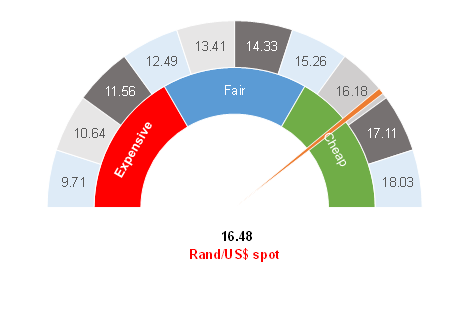Figure 1: Rand vs US dollar

Source: Anchor
It has been around two weeks since we last published our views on the rand in our quarterly strategy report entitled, The Navigator – Strategy and Asset Allocation Report 3Q20. Local data flow has been rather slow and, for much of the past two weeks, the rand was range bound in a tug of war between South Africa’s (SA’s) weak fundamentals and the global recovery. It would seem to us that SA’s COVID-19 infections are likely to peak in the next month or so and that, for the most part, SA’s experience with the pandemic will be less dire than was originally feared. This week has also seen the European Union (EU) demonstrate more cohesion than in the past by agreeing on a significant stimulus package to aid the region’s recovery. This improved EU unity, and the stimulus package itself, was well received by markets and, consequently, we have seen a weaker US dollar (which looks like a stronger rand from where we sit) and a risk-on trade with respect to SA bonds and equities. For now, markets appear to be in a state of nirvana with stimulus still flowing freely and increasing signs that the disease is becoming more manageable. All these factors should bode well for risk assets in the near term and has also bolstered the rand.
At 3PM today (23 July), the SA Reserve Bank’s (SARB’s) Monetary Policy Committee (MPC) will announce its latest interest rate decision. The consensus view is that we will see a rate cut of 0.25%, thus bringing the SARB’s total rate cuts YTD to 3.00%. However, we highlight that the SARB is gradually running out of room to cut and we think that monetary policy has done most of what it can to aid the beleaguered SA economy. We remain of the view that the structure of SA’s economy is such that quantitative easing (QE) will bring very little benefit to the real economy and is instead just a tool to weaken the rand. We do not believe that a rate cut of 0.25% is going to have much of an impact on the currency and the rand will likely be volatile at around the time of the announcement, before settling down to close at the same levels where it was trading earlier in the day.
In this context, we see that the rand is trading at around R16.48/$1 (at around 11:30 AM) having pushed below the psychological R16.50/$1 level on Wednesday (22 July). We maintain our view that the currency will slowly claw its way to below R16/$1. We have been advocating for investors to put money into currency hedges and hold back on sending money offshore above the R16.50/$1 level. However, the rand has recovered well, and the local currency is now even stronger than this threshold we had set. Thus, we will not be hedging any more currency and the discussion now should be about starting to reduce these hedges and expatriating some cash once again. We are doing this very slowly, however, as we wait for further rand recovery, in time. By and large, we are maintaining our current positioning while we wait. We are convinced that the domestic market is looking for signs of SA further reducing its Draconian lockdown rules and for global risk appetite to continue its recovery.
Figure 2: Actual rand/$ vs rand PPP model

Source: Bloomberg, Anchor




